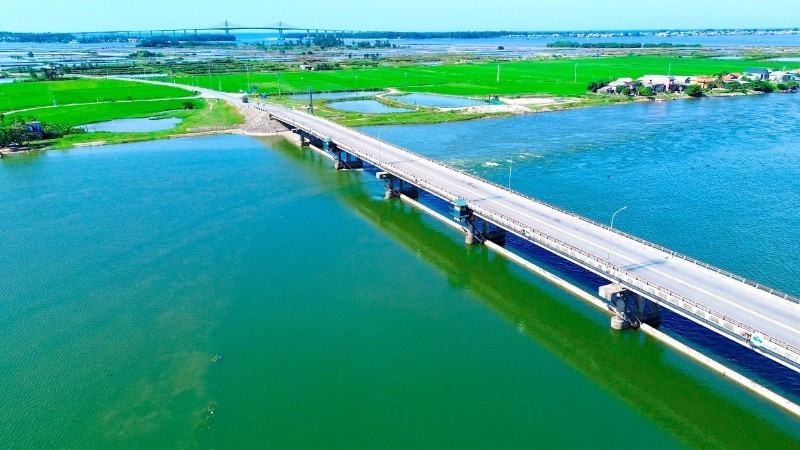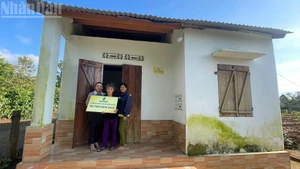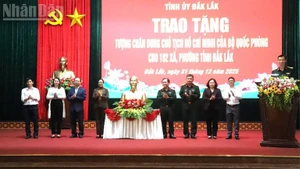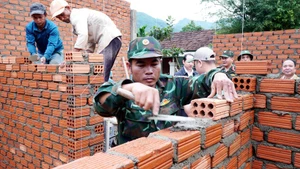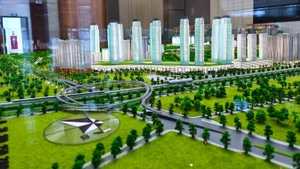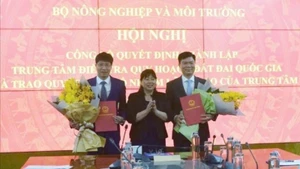Memories of brackish water
For the city’s residents, memories of brackish water are haunting. Each time high tides from Tam Giang rose, salty water would push deep into the Huong River, leaving water plants powerless. Residents in the city and downstream had to live with water that was neither fresh nor entirely salty.
Doan Minh Huong, a resident living along Dong Ba River, recalled: “Every morning I had to ride my bicycle all the way up to Tuan (the upper reaches of the Huong River), carrying two metal cans for water. The road was rough, so I had to line them with banana or taro leaves to prevent spillage. By the time I returned home, only a few buckets of fresh water remained, precious like gold. Families better off had 5 or 10-litre plastic containers, which made things a little easier. Remembering those days still brings tears to my eyes.”
Not only daily life, but also production was difficult. Farmlands along the river could only sustain one rice crop, with soil gradually degraded. During the summer-autumn season, thousands of hectares were abandoned because brackish water made irrigation impossible. Many farmers left their fields behind, moving to the Central Highlands or the south to work as hired labourers. Some boat-dwelling families rowed aluminium boats upstream to fetch fresh water to sell, but not everyone could afford it.
In 1985, severe drought and deep saltwater intrusion forced the Van Nien Water Plant to use tanker trucks to haul freshwater from upstream for city residents. In this context, the Nam Huong River irrigation system was inaugurated.
From then, Hue built several salt-prevention dams along branches of the Huong River such as An Cuu, Bach Yen, Loi Nong and Nhu Y. In the city centre, the Da Dam — standing for more than 100 years — blocked water from the Huong River into Nhu Y. Though an extreme solution that turned parts of the river into stagnant, polluted ponds, it preserved irrigation water for Phu Vang and Huong Thuy districts.
Tam Giang Lagoon stretches more than 70km from south to north, cutting Hue off to the east. Villagers wanting to cross to the other side often waited hours for ferries. Children on one bank would rush to the pier just to glimpse people arriving from the other side, bringing with them the buzz of markets and city life. Villagers longed to reach town, but the wide lagoon, with no bridge, kept them divided.
Tam Giang’s vast waters became even more treacherous under the Lao winds, with violent waves. Post-war Viet Nam was still poor, and the province could not afford bridges or dams. Residents had to rely on small ferries, braving rough waters to cross. In such circumstances, the dream of a structure that could block saltwater, preserve freshwater, and connect the two banks began to take root.
A project with two missions
After the historic flood of 1999, the Thao Long Dam project was officially proposed and approved by the Government. Construction began in 2001 and finished at the end of 2006, with an investment of over 300 billion VND (11.4 million USD). At the time, Thao Long was one of the most modern salt-prevention works in Southeast Asia, stretching 600 metres with 15 automatic sluice gates able to regulate water seasonally. Atop the dam lies a 10-metre-wide, 13-tonne-load bridge connecting National Highway 49B.
Alongside Thao Long, the province also requested construction of the Ta Trach Reservoir upstream — and both were approved. Together, they formed a strategic duo: Ta Trach holding back floods at the headwaters, Thao Long blocking saltwater downstream.
Just a few years after coming into operation, residents felt the transformation. No more brackish water for drinking, no more children with bloated stomachs from dirty water, no more salty meals. With stable freshwater, Hue flourished in developing its “smokeless industry” — tourism.
For agriculture, tens of thousands of hectares of riverside fields now received adequate irrigation, shifting from one to two rice crops a year. The Da Dam was cleared, ending pollution and reviving downstream areas with fresh water. Nhu Y fields, once saline and acidic, now produced abundant harvests.
With water secured and food sufficient, living standards rose. Families had more income to invest in their children’s education. A Hue once tormented by saltwater had now grown, building new infrastructure and advancing development.
New hopes for Thao Long
For 20 years, Thao Long has fulfilled its mission admirably. Yet climate change is worsening, saltwater intrusion is reaching further, and development demands have changed. The dam is ageing and deteriorating. Recently, the Ministry of Agriculture and Environment allocated over 120 billion VND (4.5 million USD) to repair it. Residents now expect a new Thao Long — multi-functional, aligned with the sustainable development strategy of the Huong River and Tam Giang Lagoon.
Though Hue now boasts several bridges across Tam Giang, the one on Thao Long remains unique and irreplaceable. The new structure must inherit the old strengths of blocking salt, preserving fresh water, and linking the banks — but it must also become a landscape of Tam Giang, befitting a heritage city. Not merely a “check-in” point, but a monument tied to the memories of brackish water, the dream of sweetness, and the aspiration for development.
The new Thao Long must feature flexible sluice gates that can open for tourist boats, even medium-sized seagoing vessels, to travel from Tam Giang up the Huong River into the city. When that day comes, new doors will open for both river and sea tourism across the lagoon. Visitors will be able to journey from sea into lagoon, from lagoon into river, and from the Huong River straight into the Hue Imperial Citadel.
For Hue’s people, Thao Long is no longer just a dam — it is memory, present reality, and the gateway to the future.
